#Guthrie highway
Explore tagged Tumblr posts
Text
motorbike rescue
Motorbike Rescue during emergencies within Klang Valley , Selangor and Johor Bahru , Call, 014-2458878 / 017-4387101 @motoaidmalaysia

#Motoaid#Klang valley#Yamaha malaysia#Aprilia malaysia#Vespa malaysia#Rnr#Plus highway#Kesas#Litrak#Ldp#Federal highway#Guthrie highway
0 notes
Text

Hardly Strictly Bluegrass Day Two, Golden Gate Park, San Francisco, Calif., Oct. 5, 2024
It was strictly bluegrass to kick off Day Two of Hardly Strictly Bluegrass as the Dry Branch Fire Squad offered stories about HSB founder Warren Hellman and songs of the Civil War and death and Jesus alongside instrumentals on the Banjo stage. There were no amps during the day-opening set that found the quartet playing and singing into shared mics and telling slow-to-develop tales with good humor.
Later in the day, Moonalice would grace the Towers of Gold audience with the second “White Rabbit” of the festival - following Molly Tuttle’s Oct. 4 version - and Tuttle would return with Golden Highway to back Steve Earle for a set that included a surprise appearance from Emmylou Harris on “Goodbye” and a rare festival encore of “This Land is Your Land” to end Oct. 5 in San Francisco’s Golden Gate Park.

As a warm morning turned to a sweltering afternoon that found festivalgoers gathering in shady areas and leaving sun-drenched stretches of grass empty, Jobi Riccio and her rhythm section created a stripped-back, Hejira-era Joni Mitchell/Harris hybrid for the Rooster-farians, as the emcee called those gathered at Rooster stage. Playing during Buddy Miller’s daylong Cavalcade of Stars, Riccio surely earned some new fans.

Showcasing their new How to Make Mistakes LP, Fruition entertained the Swan stage shade-seekers as the quintet with multiple lead singers and multi-instrumentalist members took a a Bandian approach to 21st-century Americana with faux-blood harmonies buttressing ballads like “Still on My Mind.”

Following immediately on the adjacent Towers of Gold, Moonalice - with drummer John Molo, guitarist Barry Sless, singer Lester Chambers, bassist Pete Sears and others - turned in a hugely entertaining and soulful set that included the front-line trio of female vocalists leading the large band through such covers as Marvin Gaye’s “You’re all I Need to Get By” the Grateful Dead’s “Bird Song,” “(Turn on Your) Lovelight” and the aforementioned Airplane number.

Back on the Rooster for the ongoing Cavalcade, former Carolina Chocolate Drop Dom Flemons played bones, harmonica, guitar and quills on traditional songs to demonstrate what being an American Songster is all about. As he performed Elizabeth Cotten’s “Freight Train,” on guitar and “Brown Skinned Girl” on harmonica, Flemons proved himself the rare solo-acoustic performer who could hold a field full of festivalgoers in rapt (near) silence.

But he also had assistance from the Red Dirt Boys - who’d previously played a rich-gumbo show of their own - on original country and western songs from Traveling Wildfire and an old-timey rendition of “Going Down the Road Feeling Bad,” as he danced with rubbery legs of joy. A couple of false starts added to the spontaneous nature of this surprise mini-set.

Carlene Carter provided midafternoon lunchtime country music as the Sound Biteses prepared for Mavis Staples on the Banjo. And she did not disappoint, cooling down the afternoon with such hopeful numbers as “I’m Just Another Soldier,” “Handwriting on the Wall” “Respect Yourself” and “Freedom Highway” as she declared the healing power of music and her gruff, joyful laugh.

“We come to bring you some joy, some happiness, some inspiration - we want you to feel good,” Staples said.
And she made people feel just that though it was disheartening to see the 85-year-old American treasure needing to sit during a portion of her show, which she did not do in Ohio several months ago.

Earle, Tuttle & Golden Highway ended the day with 75 minutes - HSB’s longest performance - and opened with “Warren Hellman’s Banjo.” The show was a little under-rehearsed but a prime example of live music without a net with songs from the Del McCoury-Earle joint the Mountain, a cover of Little Feat’s “Willin’” and perhaps the most-emphatic version of “Copperhead Road” to date.

“This turned out exactly the way I wanted it to,” an exuberant Earle said with a comment that summed up Mr. and Mrs. Sound Bites’ day perfectly.
Read Sound Bites’ HSB Day One coverage here.
10/6/24
#hardly strictly bluegrass#dry branch fire squad#jobi riccio#steve earle#molly tuttle#molly tuttle & golden highway#mavis staples#carlene carter#dom flemons#carolina chocolate drops#moonalice#emmylou harris#fruition#buddy miller#jefferson airplane#grateful dead#del mccoury#marvin gaye#elizabeth cotten#little feat#woody guthrie
5 notes
·
View notes
Text

Dylan, yesterday
#bob dylan#the times they are a changin'#a hard rain#hank williams#forever young#planet waves#blowing' in the wind#highway 61 revisited#blonde on blonde#bringing it all back home#like a rolling stone#the band#the basement tapes#woody guthrie#john wesley harding#nashville skyline#new morning#blood on the tracks#shadow kingdom#never ending tour#nobel prize#oh mercy#lay lady lay#time out of mind#fallen angels#tarantula
3 notes
·
View notes
Text

Arlo Guthrie- Alice's Restaurant (Contemporary Folk, Folk Rock, Singer-Songwriter) Released: October 4, 1967 [Reprise Records] Producer(s): Fred Hellerman
youtube
#contemporary folk#folk rock#singer-songwriter#60s#1967#Arlo Guthrie#Reprise Records#Reprise#Fred Hellerman#Highway in the Wind#Alice's Restaurant
1 note
·
View note
Text
Round 1 match ups
Deny Defend Depose by Joe Devito - Todos Juntos by Los Jaivas
Union Maid by the Almanac Singers - Color in your Cheeks by the Mountain Goats
II: The road Giveth by RENT STRIKE - Two Headed Boy by Neutral Milk Hotel
For What It’s Worth by Buffalo Springfield - I'm not a good person by Pat the Bunny
I ain't Marching Anymore by Phil Ochs - Ballad of a Wobbly by David Rovics
Do you believe in magic by the lovin spoonful - Let the Mystery Be by Iris Demont
California Dreamin by the Mama's and the Papa's - I'm a Believer by The Monkees
Hallelujah by Leonard Cohen - A Song for a Computer Programmer by Cricket!
Blackbird by the Beatles - The Gambler by Kenny Rogers
Feed the Machine by Poor Man's Poison - Curses by the Crane Wives
Big Rock Candy Mountain by Harry McClintock - Pure Obsession by Mirabai Kukathas
Closer to Fine by the Indigo Girls - I want wind to blow, the microphones
War isn't Murder by Jesse Welles - Delta Dawn by Tanya Tucker
Place to Be by Nick Drake - The Wrote and Writ by Johnny Flynn
Time in a Bottle By Jim Croce - Ohio by Neil Young
Little Lion Man by Mumford and Sons - Space Girl by Shirley Collins
A Horse with No Name by America - Fuck it by Days N Daze
The Galway Girl by Sharon Shannon and Steve Earle - The Chain by Fleetwood Mac
Heave Away by the Fables - Stick Season by Noah Kahan
Rule #4 Fish in a Birdcage by Fish in a Birdcage - Your Heart is a Muscle the Size Of Your fist by Ramshackle Glory
War on the Workers by Anne Feeney - The Funeral by Band of Horses
Blister in the Sun by the Violent Femmes - Lyndon Johnson Told the Nation by Tom Paxton
Season of the Witch by Donovan - I’m against the government by Defiance, Ohio
Everybody's Talkin' by Harry Nilsson - Kill the Boy Band by She/Her/Hers
Me and my Bobby Mcgee by Janis Joplin - O Valencia by the Decemberists
Wayward Prodigal by Cora Reef - The War Racket by Buffy Sainte-Marie
The Times they are a changing by Bob Dylan - Miracle of Life by Bright eyes
At Seventeen by Janis Ian - Little Boxes by Malvina Reynolds
I am a Union Woman by Bobbie McGee - Electricity by Sister Wife Sex Strike
Annie's Song by John Denver - Roll On, Columbia, Roll On by the Highway Men
Puff the Magic Dragon by Peter Paul and Mary - Solidarity Forever by Utah Phillipps
I'm Gonna Be an Engineer by Peggy Seegar - Follow Me up to Carlow by the Young Dubliners
Take Me to Church By Hozier - 32 Flavors by Ani Difranco
Fast Car by Tracy Chapman - Murder in the City by the Avett Brother
Mrs. Robinson By Simon and Garfunkel - The Chemical Worker's Song by Great Big Sea
The Fox by Nickel Creek - Oak & Ash & Thorn by The Longest Johns
The Wreck of the Edmund Fitzgerald By Gordon Lightfoot - Strangers by Apes of the State
American Pie by Don McLean - Our House by Crosby, Stills, Nash, And Young
Everything I own by Bread - Fire and Rain by James Taylor
The Trolley Problem by Windborne - Brown Eyed Girl by Van Morrison
Where have all the flowers gone by Pete Seeger - Dream a Little Dream of Me by Cass Elliot
Glad to be Gay by Tom Robinson Band - The Battle of New Orleans by Johnny Horton
Vienna by Billy Joel - Cats in the Cradle by Harry Chapman
One Kind of People by Amigo the Devil - Brave as a Noun by AJJ
Every Town will Celebrate by Mischief Brew - Wild World by Cat Stevens
Plastic Jesus by Tia Blake - Ho Hey by the Lumineers
Ballad of Ho Chi Min by Ewan MacColl - City of New Orleans by Arlo Guthrie
Loose Lips by Kimya Dawson - Excursion Around the Bay by Great Big Sea
Who would Jesus Bomb by Jordan Snart - Rhododendron Honey by Leslie Fish
Hungry Dog on the street by the Taxpayers - The Night They Drove Old Dixie Down by The Band
Mr. Tambourine Man by the Byrds - Nebraska by Bruce Springsteen
You're So Vain by Carly Simon - Ooh La La by the Faces
Budapest by George Ezra - Paradise by John Prine
Tear the Facists Down by Woody Guthrie - House of the Rising Sun by the Animals
One Great City by the Weakerathans - Diamonds and Rust by Joan Baez
Bread and Roses by Judy Collins - Angel From Montgomery by Bonnie Raitt
March of the Jobless Corps by Daniel Kahn - There is Power in a Union by Billy Bragg
What a time to be alive by Matt Press - Rhinestone Cowboy by Glen Campbell
Sixteen Tons by Tennessee Ernie Ford - All The Trees of the Field Will Clap Their Hands by Sufjan Stevens?
Not Yet/Love Run by the Amazing Devil - Ain't No Sunshine by Bill Withers
Tom's Diner by Suzanne Vega - It's too Late by Carole King
Hurt by Johnny Cash - Big Yellow Taxi by Joni Mitchell
Jolene by Dolly Parton - Have you ever seen the rain by Creedence Clearwater Revival
I'd work for Free by Blake Rouse - You're Dead by Norma Tanega
42 notes
·
View notes
Text
I first heard Bob Dylan on some TV show. I was maybe 10 years old. They used Shelter from the Storm in the episode. What a flawless work of art that song is. I summarily read Bob Dylan's autobiography. It was about his entire life, all his experiences. And yet- and here's the interesting thing- he only wrote about 3 albums that he wrote.
Bob Dylan has many famous albums- The Freewheelin' Bob Dylan, Highway 61 Revisited, Blood on the Tracks, Blonde on Blonde, and more. He only wrote about 3 albums.
He wrote about his first album, the start of his career, the self titled album "Bob Dylan". He wrote about the album he was writing as he was writing the very book, the album "Oh Mercy". And he wrote about his most infamous album, "Self Portrait".
I would have to make a separate post to thoroughly talk about Oh Mercy. What I remember about his first album is this: he explained that he had an interview with someone from the record label. The record guy was asking him "where are you from" "what brought you to New York" etc. They wanted a short paragraph to put on the back of the album.
Bob explains that he came to New York on a freight train. Record guy asks "You mean a passenger train?"
Bob answers, "Freight train." Then, breaking the scene, author-Bob explains he *actually* came to NY on a passenger train.
To most, Bob Dylan was, as Joan Baez described, "the original vagabond, the unwashed phenomenon". The king of the New York folk scene. It had been on the rise with artists like
Tom Paxton
and Peter, Paul and Mary,
Simon and Garfunkel.
But Bob Dylan was the one that really defined it.
Bob Dylan's real name is Robert Allen Zimmerman. He was raised in the south, Missouri. His parents were ethnic Jews and he was raised Catholic. He grew up listening to gospel music, blues, and, famously, Woody Guthrie.
But his music never sounded like he'd been raised on gospel. No, he put tradition in the wind. He was the New York dynamo, Bob Dylan!
The fame wore him out quick. For all his poetry and expression, he never felt understood. His identity was the freight train kid, not the passenger.
Years of wear and tear get to him. I get the sense he resented the people who looked up to him.
And here we get to the meat and potatoes.
Self Portrait.
Rolling Stone magazine put out an issue reviewing it. The cover stated in bold text, "What the fuck is this shit?" Bob released the album knowing it would tank his career. And man, this album is filled with gospel inspired tracks.
The album opens with "All the tired horses". Just go and fucking experience that song. Close your eyes, breath deep, and listen. Really listen.
Self Portrait is, in my mind, the greatest Dylan album.
I used to *think* I understood Dylan. But listening to Self Portrait, for the first time I *felt* I understood Mr. Zimmerman.
Thanks for reading y'all. Keep safe. You're valuable, you have a right to be here, just as much as anyone else. Just as much as the trees and stars. You matter.
:)
#Spotify#bob dylan#joan baez#peter paul and mary#tom paxton#folk music#new york#gospel#music#rock#60s#70s#60s music#hippie
8 notes
·
View notes
Note
BOB DYLAN LYRIcS AND CRAZY NOVEL LIKE RELATIONSHIP WITH JOAn bAEZ
okay i'm gonna answer this cos i was listening to joan earlier SO (and no i dont know why this is in greentext format just roll with it i'm so sorry) (this is uhh veeeeery very long too)
>1962/3
>some scruffy loser calling himself bob dylan shows up in new york with a guitar and pretty much cosplays as woody guthrie for a bit
>joan baez, who is the same age, made her debut self-titled album at nineteen years old and is well liked by everyone, her music is generally appreciated by everyone on the scene, she has a beautiful voice and strong vibrato and really good at guitar, involved in activism stuff, played with lost of older respected musicians, the whole folksinger package
>but she doesnt really write her own stuff
>bob dylan write copious volumes of material but his performance is uhhhh less than amazing and technical ability has uhm room for improvement
>his debut self titled album flops hard
>scene is pretty small so they inevitably meet
>joan is like lol look at this loser isnt he cute hehe--his songs are pretty good too huh
>she invites him to play with her, they do a bunch of shows together etc and eventually get romantically involved. joan introduces him to civil rights stuff & anti-war stuff & anti nuclear and all that stuff
>bobs stuff was already political but in a sort of abstract way, his work gets a lot more specifically activist-ey in a very powerful way
>they're still doing a lot of shows together-bob is pretty famous on the folk scene at this point, largely because of joan endorsing him pretty much lol, still romantically involved. music press starts paying attention to bob dylan and he releases quite a few albums with famous songs on them. people kinda shit on him for his voice its a whole thing but i really like his voice so whateverr
>but by 1965 music is starting to get Weird, beatles are happening etc, lots of new styles of music, new youth culture, drugs are also happening
>bob releases bringing it all back home - some of these songs have electric band backing, where previous All Bar One of his songs were solo acoustic guitar, vocals, maybe some harmonica. some people are vaguely put out by this but i think most people find it pretty cool
>20th july 1965 bob releases Like A Rolling Stone, arguably his most famous song. it is very electric and a banger and much Much more rock (it was pop then but yknow) than folk. young people go YAY YIPPEE
>newport folk festival 25th 1965 (five days later) bob plays with an electric band (later to be known as The Band) to Outrage from folk purists who thought he was their god etc. someone shouts 'judas' at the stage implying he was betraying folk music by going electric and that guy must absolutely shit himself every time he remember that he did that because goddamn. pretentious twenty-somethings who hadnt even liked folk music before bob dylan get mad at him, old folk singers are mad at him, popular myth says the famously pacifist pete seeger threatened to cut the power cable with an axe. everyone is Big Mad except like a rolling stone goes hard and people who care a bit less about Proper Folk Music think its a banger
>highway 61 revisted comes out and bob dylan is now a major sensation amongst music enjoyer everywhere, like his stuff is really really cool, new and exciting, also decidely Not Folk but like really very cool. bob also starts smoking weed and taking speed b/c ofc he does & if you look him up he looks like twelfth doctor with the sunglasses and the hair and i'm right on that
>joan is still doing traditional folk music mostly. she is less than amused at bob going electric but iirc mostly polite about it. later that year she released 'farewell, angelina' an album of covers of bob's songs. a lot of them are Very Good, all sung with much more skill than bob could ever hope for sorry bob. which is like. Damn Okay Joan Thats A Move but it was probably finished before newport.... idk..........
>england is suddenly like OMG BOB DYLAN????????? at around 1964/65 but it takes a long time for music to get over there b/c the british music industry had a thing about only selling uk artists so american records were special import it's a whole thing. so people are just getting his famous folk stuff riiiight as he changes his mind about that and starts doing rock music instead, though still with a very poetic bent
>on a related note uk albums were often released differenet in north america to 'appeal to american audiences'?? so the version of the beatles rubber soul that inspired bob dylan and like lou reed and Everyone is kinda of.... wrong...... its weird
>bob n joan's relationship is kinda strained at this point, due to musical differences and yknow relationship stuff, not helped by the fact that bob could be a bit of a prick and was also quickly accumulating A Legend around him. not helped by his insanely cryptic and often nonsensical interview responses.
>at some point in the middle of all this bob marries Sara Lownds in secret. no one knows. he doesnt tell joan. he's not With with joan anymore but she didnt know he was literally marrying someone else. apparently sara wasnt really a music person and didnt know exactly why he was so famous.
>1966 uk tour (this is filmed in d.a. pennebaker's DONT LOOK BACK (no apostrophe. cos dont & look & back all have four letters so it fits on a poster and the apostrophe would muck up teh symmetry also they were all really fuckin pretentious)). bob is playing mostly electric sets with The Band (known then as the Hawkes) which was A Choice To Be Sure
>some people love it but all the folk purists think he's awful and bad and terrible boo him offstage etc which is pretty terrible
>he starts taking a lot of drugs. music gets Weirder. he's kinda not doing too good
>joan shows up partway through the tour and its......awkward....... to say the least. he'd kind-of-not-really-ish broken up with her & then got married to someone else but she just inserted herself in there. idk why. the whole of dont look back he's kinda dismissive of/rude to her ngl
>meanwhile his Mythos has built to uncontrollable levels. he doesnt exactly help this b/c he's very clever with words so people would obvious find meaning in his lyrics, and when he spit nonsense in interviews people would often find a method in the madnes yknow?? like he's smart. he's also really weird. but people have started reading WAYYYYYYYYYYYYY too much into EVerything he says and does. like everything. like idek what a modern comparison would be. gaylors have nothing on this shit. understandably he gets pissed off at people asking stupid questions
>joan has a girlfriend at this point also. like yeah in a lesbian way. she says she's straight but she did have a girlfriend her name was kimmy
>blonde on blonde comes out in '66. its his most......... 60s album if you know what i mean. like its lots of drugs and lots of instruments and plays on words and its very good, big double album, he's looking super hip on the cover, songs rumoured to be about edie sedgwick, the whole shebang. the lyrics are inspiration for batshit insane theories for decades to come even though a lot of it likely is just in there cos it sounds cool and rhymes.
>includes the song 'sad eyed lady of the lowlands', which is about sara. joan thinks its about her and says so. bit awkward. its a beautiful song and bob never plays it live, it was recored at like three in the morning and the band didnt know how long it was gonna be etc etc lots of myth
>in november 1966 bob dylan has a motorcycle acciedent near his home in woodstock new york state and is in hospital. music enjoyers everywhere Very concerned. he's okay, and after this more or less disapears from public life for a bit. has a bunch of kids. just chilling in the countryside. does a bunch of jamming with The Band, lives of royalities etc. tries to avoid people mostly. this mysterious disapearance combined with blonde on blonde fuels a lot of theorising by fans which he thinks is stupid
>in just five years bob did more musical innovation than most muscians could ever hope to, and he Never WOuld Have been Famou s WIthout Joan.
>joan is getting even more involved in activist work as the vietman war drags on and on. still doing folk music. she has electric instruments in her stuff eventually but still in a definitively Folk Style. she plays at the Woodstock Festival in 1969, she got married too, doing lots of activism stuff, everyone still really likes her music. 1969 bob relases his country album which most people (bob included) think is kinda trash
>1972 joan releases 'to bobby' (she called him bobby a looooong time after everyone just called him bob). which is. Wow. its uhmmm. well. it's a song beseeching bob to come out of retirement and help out with the anti-war cause. lots of musicians though that is he wrote a good new anti-war song it would really help the cause like he used to in the early sixties. bob was pissed at this like relaly annoyed he though she was being far too presumptuous and i really gotta agree with him there like dude's been through enough.
>1975, bob's been back touring for a year -ish. he decide's he gonna put together the ROLLING THUNDER REVUE which is pretty much him & all his friends who are also folk.country.rock whatever you wanna call it musicians and they go arund a whole bunch of little venues and generally have a good time. lineup includes joni mitchell robbie robertson roger mcguinn emmylou harris, a very cool violin player called scarlett (i think) allen ginsberg the poet who had a gay crush on dylan in the sixties, the blonde guitarist from ziggy stardust AND JOAN BAEZ :D there are like ten people on the stage at once and loads of guitars and various string instruments etc and they redo all these dylan songs in new and exciting ways.
>they film some of it to make this move called Renaldo and Clara. i havent seen it (yet) but its like a semi-fiction semi-documentary film about the tour and also some sort of plotline they string together from somewhere idk. joan is in this film too. from what ive seen there are some uhh. some fairly OUGH scenes, on top of bob n joan singing together on stage all the time. there s clip of bob saying that he n joan could sing together in their sleep. she is still a wayyyy better singer than him but his voice is really good these years and they way they do the songs together is veeeeryyyyy cool. theres a scene in the film where bob says (and i quote) 'it really displeases me that you went off and got married' (OUT OF NOWHERE MIGHT I ADD) and joan says 'you went off and got married first and didnt tell me' and he doesnt really have an answer to that. like GODDAMNIT BOY
>there another scene where there was a bit of a script but joan went off and said something like 'do you know why we never couldve got married?' and bob was apparently bad at improv so he wasnt saying anything and so joan just kept talking going through all the reasons why they never got married and all the issues between them. On Camera. like damn.
>also in 1975 joan's album Diamonds & Rust comes out. the title track is one joan wrote herself and it is Very Clearly about bob and its uhhh a little bit scathing. also very very good. generally regarded as one of her best songs. awkward as you can imagine. 'my poetry was lousy you said' 'we both know what memories can bring / they bring diamonds and rust' 'you burst on the scene already a legend'
Now you're telling me You're not nostalgic Then give me another word for it You who are so good with words And at keeping things vague 'Cause I need some of that vagueness now It's all come back too clearly Yes, I loved you dearly And if you're offering me diamonds and rust I've already paid
LIKE GODDAMN JOAN OKAY
>bob gets divorced from sara in 1976? 77? idk that happens too. i think joan gets a divorce too but not sure.
>theres a bit gap in my knowledge here idk what happens to them specifically after that. like i know a bunch about bob but nothing relevant rn. hes christian for a bit. makes some albums that suck and some that are good. joan still does folk music & mostly covers.
>in 2003 bob releases a memoir called Chronicles Vol. I (supposedly of three but theres only one lol). he talks about joan a bit, how could he not, describes how he was so envious of her when he was 21 and saysing 'she looked like a religious icon, like somebody you'd sacrifice yourself for'. super normal thing to say about your ex ahaha.
>2022 the rolling thunder revue film comes out (its a netflix film but also. internet archive) and they're both interviewed for it. some iconic moments. i think most interviewers sort of stopped asking joan about bob out of politness after a while but obviously she talks about him there thats what the films about. yeagh.
>joan baez like hangs out with lana del ray n stuff now & has books out or her little drawings. she also paints. and bob still tours at 82 (almost 83) years old. and still relreases new stuff. yeagh
ANYWAYS the concise history of Joan Baez and Bob Dylan. sources: dude trust me ahahah no but the source is the 2022 rolling thunder film, dylan's chronicles and around a year of being obsessed with bob dylan. he was my real life old guy blorbo fr.
#I ALMOST BOUGHT ONE OF JOAN OLD MEMOIRS ONE TIME#it was an out of print one but when i saw it it was right before i got obsessed with her and i didnt have any money so i didnt buy it and i#cant get it anywhere. never getting over that one#anywayssss ahahaha#joan baez#bob dylan#sorry this is quite a lot but. yeag its a lot#thanks for the ask!!#lin tag :D
16 notes
·
View notes
Text

Bob Dylan, born Robert Zimmerman on May 24, 1941, in Duluth, Minnesota, is one of the most influential and groundbreaking figures in the history of music. Over the course of his career, which spans more than six decades, Dylan has made an indelible impact on the worlds of folk, rock, and popular music, transforming the way music is written, performed, and interpreted. Known for his profound lyrics, distinctive voice, and innovative approach to songwriting, Dylan has earned acclaim as one of the greatest poets of the 20th century, with his work often reflecting themes of social change, personal reflection, and existential questioning.
Dylan’s early life was shaped by his family’s move to Hibbing, Minnesota, where he grew up and developed an interest in music. He was influenced by a wide range of genres, including blues, folk, country, and rock and roll, and by the time he was a teenager, he had started performing in local clubs and bars. In 1961, he moved to New York City with the aim of pursuing a career in music. There, he immersed himself in the folk music scene and became a protégé of folk legend Woody Guthrie, whose influence on Dylan’s early work would be profound.
Dylan’s debut album, Bob Dylan (1962), was a modest beginning, featuring a blend of folk covers and a few original songs. However, it was his second album, The Freewheelin' Bob Dylan (1963), that marked the beginning of his transformation into a cultural and musical icon. The album contained some of his most famous songs, including “Blowin' in the Wind” and “A Hard Rain’s a-Gonna Fall,” which resonated deeply with the political and social unrest of the 1960s. His lyrics, which were poetic, ambiguous, and open to interpretation, quickly earned him a reputation as a spokesman for the youth counterculture and the civil rights movement.
Throughout the early 1960s, Dylan’s music evolved rapidly. His songwriting became more complex, and his lyrics often tackled themes of social justice, alienation, and political activism. Songs like “The Times They Are A-Changin'” became anthems of social change, while others, such as “Masters of War” and “With God on Our Side,” showcased his growing sense of disillusionment with authority and war.
However, Dylan's career took a dramatic turn in 1965, when he famously "went electric." At the Newport Folk Festival, Dylan shocked his folk music fans by performing with an electric band, abandoning his acoustic roots for a more rock-oriented sound. This move was met with controversy and divided his fanbase, but it also opened up new musical possibilities for Dylan. His albums Bringing It All Back Home (1965) and Highway 61 Revisited (1965) blended rock, blues, and folk influences, marking a creative high point with songs like “Like a Rolling Stone,” which is often considered one of the greatest rock songs of all time.
4 notes
·
View notes
Text
As someone who loves American folk music, I absolutely despise the fact that we chopped off the end of one of our best folk songs, completely stripping it of its meaning.
The song? Woody Guthrie's This Land is Your Land.
If you grew up in the states, you probably learned it somewhere, it's a chill little song about American unity, and how pretty it is here. Here's the part they teach in schools, in churches, and so on:
This land is your land, and this land is my land
From California to the New York island
From the Redwood Forest to the Gulf Stream waters
This land was made for you and me
As I went walking that ribbon of highway
I saw above me that endless skyway
Saw below me that golden valley
This land was made for you and me
I roamed and rambled, and I followed my footsteps
To the sparkling sands of her diamond deserts
All around me, a voice was sounding
This land was made for you and me
When the sun come shining, then I was strolling
And the wheat fields waving, and the dust clouds rolling
The voice was chanting as the fog was lifting
This land was made for you and me
This land is your land, and this land is my land
From California to the New York island
From the Redwood Forest to the Gulf Stream waters
This land was made for you and me
When the sun comes shining, then I was strolling
And the wheat fields waving and the dust clouds rolling
A voice come chanting and the fog was lifting
This land was made for you and me
Oh, sweet, we all belong here is this lovely country! Right? Wrong. Here's the end:
As I went walking I saw a sign there,
And on the sign it said "No Trespassing."
But on the other side it didn't say nothing.
That side was made for you and me.
In the shadow of the steeple I saw my people,
By the relief office I seen my people;
As they stood there hungry, I stood there asking
Is this land made for you and me?
Nobody living can ever stop me,
As I go walking that freedom highway;
Nobody living can ever make me turn back
This land was made for you and me.
2 notes
·
View notes
Text
Does art make a difference?
Aw, sure. Of course there are degrees of extremity to the potential change that art can effect, depending on how many people are able to engage with it. The Beatles made a huge difference in the world. But Henry Darger, Jeff McKissack, Karen Dalton, Pauline Oliveros, Kenneth Patchen – there are so many folks who have made great art and not gotten massively famous for it, yet I think there are all sorts of ways their work informs and shapes other people’s work, and brains, and decisions.
Should politics and art mix?
Well, everything mixes, the New Statesman! That’s like asking if a knee-reflex hammer and a quadriceps tendon should “mix”.
Is your work for the many or for the few?
That’s for the many/few to say. I just crank out the hot jams.
If you were world leader, what would be your first law?
Gravity. I feel like we need to tighten up the constitutional protections that particular law enjoys. It’s a ticking time bomb, if you ask me.
Who would be your top advisers?
Cute angel on one shoulder, cute devil on the other.
What, if anything, would you censor?
Maybe we could all agree to not bust each other’s chops all cut-dang day.
If you had to banish one public figure, who would it be?
Don’t know, banishment might be a little extreme, but I’d sure like to take that Stephen Hawking dude down a notch or two. Right? Are you with me?
What are the rules that you live by?
Basically, “bros before hos”. I feel like if you stay true to that, everything else just kind of falls into place.
Do you love your country?
I love William Faulkner, Dolly Parton, fried chicken, Van Dyke Parks, the Grand Canyon, Topanga Canyon, bacon cheeseburgers with horseradish, Georgia O’Keeffe, Grand Ole Opry, Gary Snyder, Gilda Radner, Radio City Music Hall, Big Sur, Ponderosa pines, Southern BBQ, Highway One, Kris Kristofferson, National Arts Club in New York, Ruth Crawford Seeger, Joni Mitchell, Ernest Hemingway, Harriet Tubman, Hearst Castle, Ansel Adams, Kenneth Jay Lane, Yuba River, South Yuba River Citizens League, “Alice Doesn’t Live Here Anymore”, “Hired Hand”, “The Jerk”, “The Sting”, “Butch Cassidy and the Sundance Kid”, clambakes, lobster rolls, s’mores, camping in the Sierra Nevadas, land sailing in the Nevada desert, riding horseback in Canyon de Chelly; Walker Percy, Billie Holiday, Drag City, Chez Panisse/Alice Waters/slow food movement, David Crosby, Ralph Lauren,San Francisco Tape Music Center, Albert Brooks, Utah Phillips, Carol Moseley Braun, Bolinas CA, Ashland OR, Lawrence KS, Austin TX, Bainbridge Island WA, Marilyn Monroe, Mills College, Elizabeth Cotton, Carl Sandburg, the Orange Show in Houston, Toni Morrison, Texas Gladden, California College of Ayurvedic Medicine, Louis Comfort Tiffany, Saturday Night Live, Aaron Copland, Barack Obama, Oscar de la Renta, Alan Lomax, Joyce Carol Oates, Fred Neil, Henry Cowell, Barneys New York, Golden Gate Park, Musee Mechanique, Woody Guthrie, Maxfield Parrish, Malibu, Maui, Napa Valley, Terry Riley, drive-in movies, homemade blackberry ice cream from blackberries picked on my property, Lil Wayne, Walt Whitman, Halston, Lavender Ridge Grenache from Lodi CA, Tony Duquette, Julia Morgan, Lotta Crabtree, Empire Mine, North Columbia Schoolhouse, Disneyland, Nevada County Grandmothers for Peace; Roberta Flack, Randy Newman, Mark Helprin, Larry David, Prince; cooking on Thanksgiving; Shel Siverstein, Lee Hazlewood, Lee Radziwill, Jackie Onassis, E.B. White, William Carlos Williams, Jay Z, Ralph Stanley, Allen Ginsberg, Cesar Chavez, Harvey Milk, RFK, Rosa Parks, Arthur Miller, “The Simpsons”, Julia Child, Henry Miller, Arthur Ashe, Anne Bancroft, The Farm Midwifery Center in TN, Martha Graham, Alvin Ailey, Jr., Eleanor Roosevelt, Clark Gable, Harry Nilsson, Woodstock, and some other stuff. Buuuut, the ol’ U S of A can pull some pretty dick moves. I’m hoping it’ll all come out in the wash...
Are we all doomed?
If we keep our expectations pretty low I think we might be fine. I mean, we’re definitely all dying at some point. There’s no getting around that. But between now and then, things might start looking up!
— Joanna Newsom for The New Statesman, 2008
#joanna newsom#isn't she simultaneously just the most hilarious and thoughtful person?#i love her so much#a few people have asked me for that one quote about loving her country but the whole interview is a real gem i hope y'all enjoy it#love joanna#jnew
19 notes
·
View notes
Text
In which James Fitzjames meets James Fitzjames in the afterlife, the portal to which happens to be inside the walk-in freezer of a Bible Belt Taco Bell:
The stranger’s jaw clicks and slides beneath James’ lips, an unnatural looseness.
“No,” the stranger murmurs, ever genial. “I’m ever so sensitive about the old jaw.”
James murmurs acknowledgment, moving instead up toward the ear, crowded round with brown curls. His hair smells freezer-burnt and charred at once. Ah, well. James didn’t smell like violets himself, what with his breath like tarnished copper, the delicate lattice-work of blood about his own hairline. Even the scattering of unquiet holes reopening down his ribs and belly had a smell about them like cheap wine, mashed meat, lead.
But you take what you’re given here, whatever is recognizable as human when it makes its way out of the walk-in: before this it was the waterlogged Norwegian, shaking the crisp-stenched Bering Sea from his furs like a dog. He had an Easter Island sort of face and you could hear the roar as of a great engine at his back as the walk-in door swung shut behind him.
“Has Fred come yet?” He asked. An unpalatable directness about him.
“Fred? No Fred yet. We have had a Frank—handsome, though his chest smoldered. And a Francis is expected, if he ever deigns to put in an appearance.”
The Norwegian was in no mood for conversation. “When Fred comes, tell him I’ve gone on to Buffalo.”
“Where is that? And who might you be?”
“He’ll know where. He knows who.”
Mostly James was a messenger. He met them at the portal, which had been improbably placed inside the walk-in freezer of a Taco Bell cantina just off the highway in Guthrie, Oklahoma, and he passed messages along. Gave directions. Eavesdropped on the living, kept his little lonely journal on napkins.
But sometimes he was blessed with a companion. This stranger had come striding out looking around alertly, smiling genially, and it was—oh, a magnetism so great it almost hurt. A sense of familiarity. They did not even have to speak. As though this were husband, brother: like beneath his naval dress he knew the body he’d find there, the wounds a miraculous echo of his own.
Now the stranger was carefully working James loose of his layers. There in the dingy restroom he did not even care if he saw himself as he was. He could face it.
“You’re the handsomest man I ever saw,” said the stranger, running his hands down James’ gaunt, mottled ribcage. Each bone, each furrow, lovingly mapped out.
“Listen,” he continued. “When we are finished here—I’m famished. Is there food near?”
“Do you like tacos?”
“I’ve no idea what a taco is. I’d like anything.” By now he’d knelt—wincing as though his knees were glass—and laid his palms on James’ open thighs. “You I’d like best of all.”
“Have you always been so charming?”
“Oh, yes. And you so lovely?”
James nods. “Yes, always.”
Ao3 link:
#the terror#the franklin expedition#James Fitzjames#fan fiction#polar exploration fic#mini fic#bangmasfest
6 notes
·
View notes
Text
Decisions, Decisions
Thursday, October 12, 2023
It is decision time. Today we need to make a firm, clear, hard, solid, unalterable, set in stone, unbreakable decision about where the weather will be optimal, or at least workable, to see the eclipse. The eclipse track is a two day drive from where we are in Kansas. And those darn weather predictions are not yet firm enough to guide a firm, clear, hard, ..., well, you see the problem.
If we go south, the weather looks more favorable, but is in the wrong direction for the friends we want to visit on Sunday. If we go west, which takes us more in the direction of our friends, the weather is unsettled. We decide to wait until we reach Wichita, Kansas to choose which direction to take.
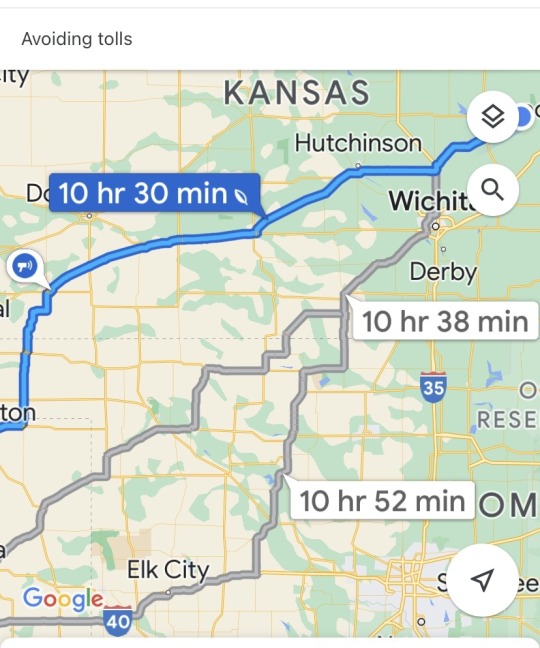
I'm the meantime, Tim's nephew cooks us a fabulous breakfast. A mound of luscious hash brown potatoes, bacon cooked to perfection in the oven, and scrambled eggs toped with Cholula hot sauce start our day with our mouths happy and our bellys full. Dora had fun playing with Spot, a chihuahua mix. After happy goodbyes, we set the GPS for Wichita and head out.
As we drive, we learn more geography than we had really wanted to know. Head west to Farmington, Albuquerque, or Roswell New Mexico? South to Hobbs, Odessa, or Midland Texas? The weather report that had earlier said Roswell would be clear now says partly cloudy. And the weather report for our original destination of Farmington looks like it is improving. Two Spellmans in our heads. Argh!
We leave the highway and head down a dirt road looking for a place to lunch and collect our thoughts. We stop between a harvested corn field and a dormant oil well. Dora is so full of curiosity for the sounds and smells of the field that she ignores her ball.
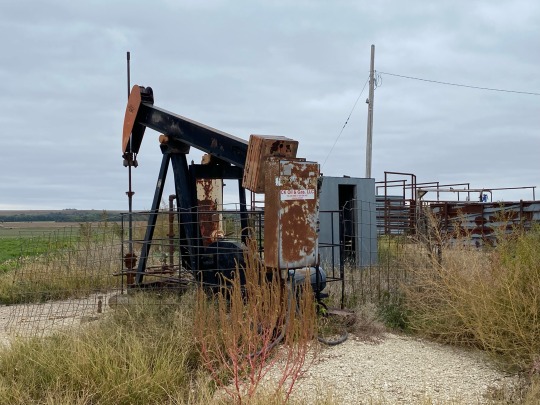
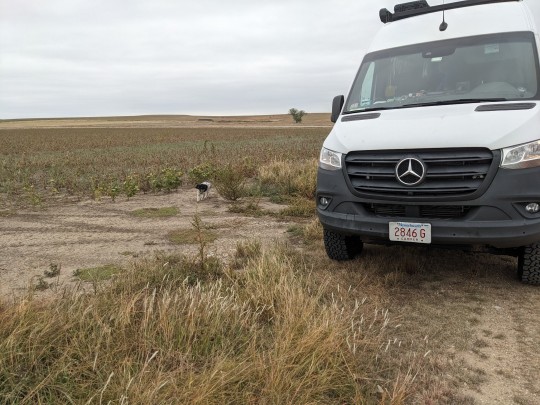
We eat leftover Thai red curry and rice from last night. It is still decision time. We are fortified with food and with three different weather reports that favor Farmington. We decide: Farmington it is.
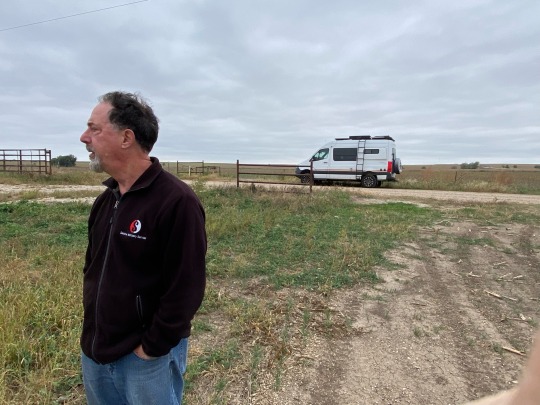
The wind picks up as we head across central Kansas. The National Weather Service has forecast winds of 35 MPH, gusting to 50. The dust clouds the air in every direction. It brings to mind Woody Guthrie's song of the dust bowl era, "Dusty Old Dust."
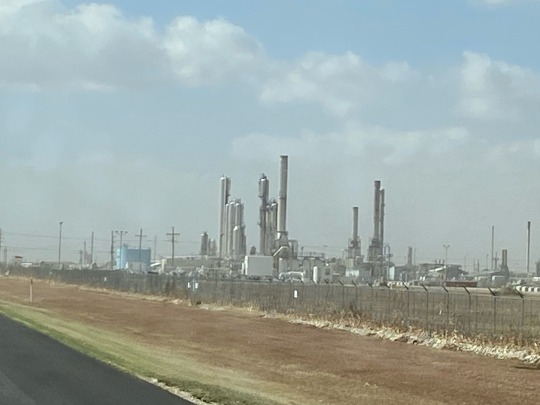
This is the oil-producing section of Kansas. We wonder how they, whoever "they" is, keep the oil separate from the produce.
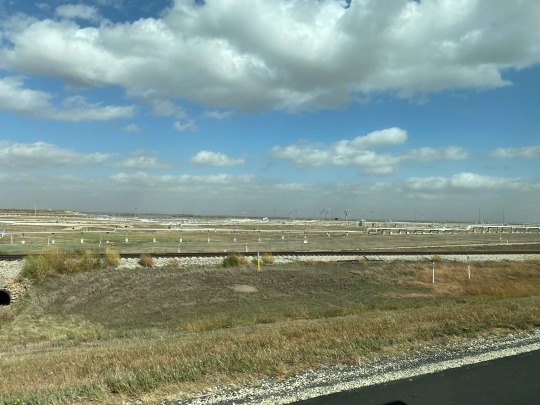
U.S. 56 heads west along the plains. The wind is blowing from the South. Hard. The driver has to hold the wheel left just to stay going straight. The speed limit is 65, while the road is a single lane in each direction with a two-foot breakdown "lane." Each time we meet a big rig coming toward us, we slam into its wake, immediately dropping our speed by 2 MPH. As we pass it, we get yanked toward its lane, and have to be ready to re-center ourselves before the next oncoming vehicle arrives. Everyone is shading themselves toward the side of the road. The beeping of the lane keeping assist warning is incessant. It is so nerve-wracking that we abandon the regular two-hour shifts for one-hour shifts or less.
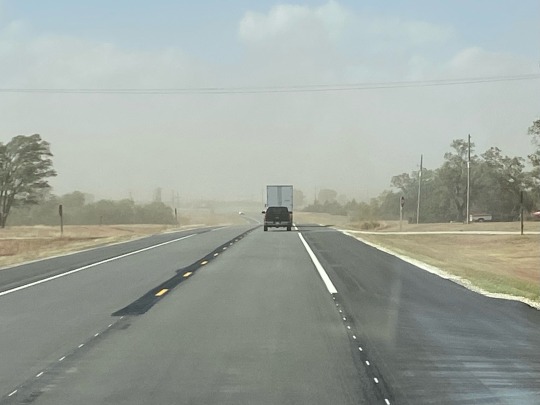
We stop for water in a small town with (not one but!) two public parks that RVs can use. To our right was a deserted fairgrounds and across the street the endless farm fields restarted. The temperature was 86°, although the RV thermometer got up to 106° in the sun. We didn’t pack for hot weather, but the high winds kept us comfortable in tshirts and jeans.
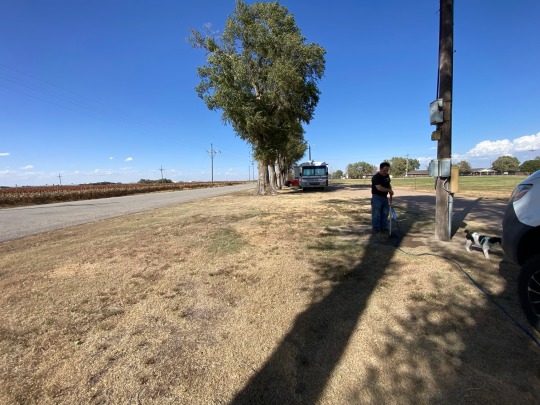
We stopped for the night at a pleasant rest area at the crossroads of two state highways. Tim opened the door and at least a dozen flies came in. Jeanne screamed and Tim hastily retreated from whatever he wanted from the front seat. The rest of the night was split between planning how to minimize opening the doors and swatting flies.
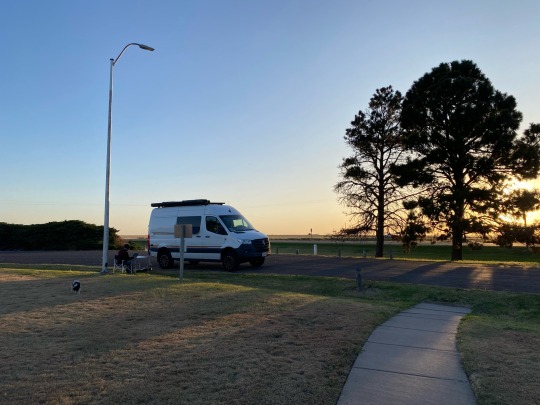
The howling winds continued to shake the RV hard all night long.
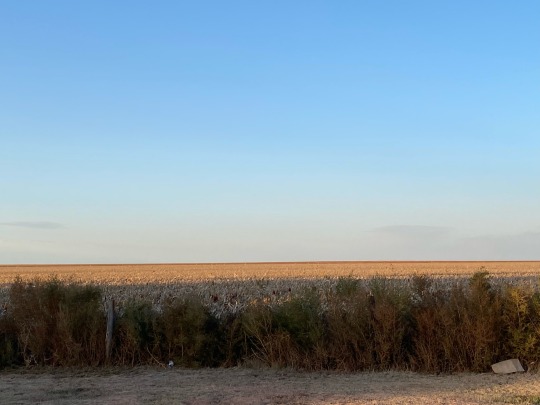
3 notes
·
View notes
Text

PAL-077 Kris Gruda LP
"Plays For You"
It's tempting to view guitarist Kris Gruda, a North Carolina resident, as part of a lineage of demented Southern avant-pickers stretching back to Chadbourne, and while that's not false, it's unnecessarily reductive. Gruda is but one particle in a contemporary wave of traveling minstrels plying the
interstates and unnumbered highways of the Deep South, navigating between pickup gigs in urban centers from Asheville to Baton Rouge to Jacksonville to Amarillo, dipping into the free jazz songbook and a bottomless bag of capital-I-improv tropes to play for audiences of 0-50 intrepid listeners (most of them musicians themselves). Against all odds (and despite dismissal by a sea of jaded music "connoisseurs'' who would prefer to devour overpriced reissues than to attend actual performances), these musicians develop an evolving sonic language, unencumbered by dreams of success; nurtured by the promise of social connection, gas money, and the next bag of Beaver Nuggets.
Whether or not Gruda is one of these compulsive road-trippers is beside the point, because (as amply evidenced by his instagram account, @Grudakris) Gruda clearly spends a lot of his time in his car. Kris Gruda Plays for You was recorded entirely behind the wheel under lockdown in 2020-2021, mostly during shift breaks at the kombucha factory. Each track is a separate Instagram post, downloaded and spliced together into two unbanded sides (a la Beefheart's Strictly Personal), and as such, represents an audio verite tour of a musical vision that, amoeba-like, engulfs two worlds separated by a windshield -- the spinning car wash brushes, the passing cop cars, the preacher on the radio.
The cover (Gruda in a hairnet, oozing Waylon's outlaw bit and clutching a stickered acoustic) supplies a little bit of the IG multimedia appeal missing from the audio, but the sound ("without which none of this is possible," states Gruda) supplies an expansive narrative by itself. Each track, from the "Vote him Out" rap to the dual tracks of "Vehicular Sound Collage," is a gem of creative outreach, a stab not only against the claustrophobia behind the steering wheel, but also a rebellion against the forced isolation of the lockdown itself. The politics of Plays For You are Guthrie-direct, speak to individual action, and seek to inspire us to reach beyond our silos and attempt to reconstruct a virtual solidarity we could once access via a physical commons. But I suspect what will resonate most with listeners are the plaintive cries voiced by a canny (and virtuosically played) selection of classics by Coltrane, Kirk, Coleman, and Cherry, tiny scraps that remind us of a once-encompassing musical spirituality that spurred a half-dozen would-be revolutions (and which may someday do so again). Ultimately, the enthusiasm (and massive doses of sheer weirdness) Gruda exudes in Kris Gruda Plays for You lights up a big, friendly highway into the heart of a deeply idiosyncratic and charismatic vision that's a gas to listen to even stripped of its social media spectacle -- so put down your phone and just listen. — Tom Carter
2 notes
·
View notes
Text
"This land is your land, and this land is my land From California to the New York island From the Redwood Forest to the Gulf Stream waters This land was made for you and me
As I went walking that ribbon of highway And I saw above me that endless skyway I saw below me that golden valley This land was made for you and me
I roamed and rambled, and I've followed my footsteps To the sparkling sands of her diamond deserts All around me, a voice was sounding This land was made for you and me
There was a big, high wall there that tried to stop me A sign was painted said "Private Property" But on the backside, it didn't say nothing This land was made for you and me."
Woody Guthrie.
(But was it? That land was taken from those who once called it home.
Progress, by its nature, progresses.
Build on what the great artists of the past created, and always look forwards.)
The kids on TikTok think that just because he was a classic country singer, Johnny Cash was conservative??? My babies he covered a Nine Inch Nails song in his seventies.
Classic country singers (the majority of which came from poor roots) were always talking about how much The Man sucked because they were taking money from poor rural folk. You’re gonna tell me that’s conservative?? Get outta here.
126K notes
·
View notes
Text
Adjusted Round 1 match ups
I’m against the government by Defiance, Ohio - Little Boxes by Malvina Reynolds
Vienna by Billy Joel - Miracle of Life by Bright Eyes
Hungry Dog on the street by the Taxpayers - Big Yellow Taxi by Joni Mitchell
Excursion Around the Bay by Derina Harvey band - I am a Union Woman by Bobbie McGee
Jolene by Dolly Parton - Wild World by Cat Stevens
At Seventeen by Janis Ian - The Battle of New Orleans by Johnny Horton
Everybody's Talkin' by Harry Nilsson - Do you Believe in Magic by the Lovin Spoonful
Blackbird by the Beatles - Mr. Tambourine Man by the Byrds
Puff the Magic Dragon by Peter Paul and Mary - Blister in the Sun by the Violent Femmes
Ooh La La by the Faces - Ain't No Sunshine by Bill Withers
Tear the Facists Down by Woody Guthrie - Fire and Rain by James Taylor
Rule #4 Fish in a Birdcage by Fish in a Birdcage - Strangers by Apes of the State
Angel From Montgomery by Bonnie Raitt - I'd work for Free by Blake Rouse
I'm not a good person by Pat the Bunny - Ho Hey by the Lumineers
Lyndon Johnson Told the Nation by Tom Paxton - Pure Obsession by Mirabai Kukathas
Not Yet/Love Run by the Amazing Devil - Budapest by George Ezra
Diamonds and Rust by Joan Baez - Paradise by John Prine
What a time to be alive by Matt Press - Ballad of a Wobbly by David Rovics
Glad to be Gay by Tom Robinson Band - Nebraska by Bruce Springsteen
All The Trees of the Field Will Clap Their Hands by Sufjan Stevens? - Kill the Boy Band by She/Her/Hers
Every Town will Celebrate by Mischief Brew - Oak & Ash & Thorn by The Longest Johns
The Galway Girl by Sharon Shannon and Steve Earle - Curses by the Crane Wives
You're So Vain by Carly Simon - The Chemical Worker's Song by Great Big Sea
I'm Gonna Be an Engineer by Peggy Seegar - Follow Me up to Carlow by the Young Dubliners
American Pie by Don McLean - Murder in the City by the Avett Brother
Rhododendron Honey by Leslie Fish - The Fox by Nickel Creek
California Dreamin by the Mama's and the Papa's - Ohio by Neil Young
It's too Late by Carole King - There is Power in a Union by Billy Bragg
Have you ever seen the rain by Creedence Clearwater Revival - I ain't Marching Anymore by Phil Ochs
The Wrote and Writ by Johnny Flynn - Wayward Prodigal by Cora Reef
Landslide by Fleetwood Mac - Place to Be by Nick Drake
Space Girl by Shirley Collins - Little Lion Man by Mumford and Sons
Delta Dawn by Tanya Tucker - Where have all the flowers gone by Pete Seeger
Take Me to Church By Hozier - Solidarity Forever by Utah Phillipps
Let the Mystery Be by Iris Demont - Brave as a Noun by AJJ
A Horse with No Name by America - Mrs. Robinson By Simon and Garfunkel
Tom's Diner by Suzanne Vega - A Song for a Computer Programmer by Cricket!
War on the Workers by Anne Feeney - War isn't Murder by Jesse Welles
Me and my Bobby Mcgee by Janis Joplin - For What It’s Worth by Buffalo Springfield
You're Dead by Norma Tanega - The Gambler by Kenny Rogers
Color in your Cheeks by the Mountain Goats - March of the Jobless Corps by Daniel Kahn
Stick Season by Noah Kahan - O Valencia by the Decemberists
Fuck it by Days N Daze - Dream a Little Dream of Me by Cass Elliot
Hallelujah by Leonard Cohen - The Night They Drove Old Dixie Down by The Band
Deny Defend Depose by Joe Devito - Big Rock Candy Mountain by Harry McClintock
Annie's Song by John Denver - The Funeral by Band of Horses
Union Maid by the Almanac Singers - 32 Flavors by Ani Difranco
Our House by Crosby, Stills, Nash, And Young - Fast Car by Tracy Chapman
The War Racket by Buffy Sainte-Marie - Hurt by Johnny Cash
One Great City by the Weakerathans - Loose Lips by Kimya Dawson
Feed the Machine by Poor Man's Poison - Everything I Own by Bread
I want wind to blow, the microphones - City of New Orleans by Arlo Guthrie
Todos Juntos by Los Jaivas - II: The Road Giveth by RENT STRIKE
Roll On, Columbia, Roll On by the Highway Men - Ballad of Ho Chi Min by Ewan MacColl
Brown Eyed Girl by Van Morrison - Time in a Bottle By Jim Croce
The Trolley Problem by Windborne - One Kind of People by Amigo the Devil
Season of the Witch by Donovan - House of the Rising Sun by the Animals
The Times they are a changing by Bob Dylan - Cats in the Cradle by Harry Chapman
Closer to Fine by the Indigo Girls - Two Headed Boy by Neutral Milk Hotel
Heave Away by the Fables - Your Heart is a Muscle the Size Of Your fist by Ramshackle Glory
Who would Jesus Bomb by Jordan Snart - Electricity by Sister Wife Sex Strike
Rhinestone Cowboy by Glen Campbell - Plastic Jesus by Tia Blake
The Wreck of the Edmund Fitzgerald By Gordon Lightfoot - Bread and Roses by Judy Collins
Sixteen Tons by Tennessee Ernie Ford - I'm a Believer by The Monkees
29 notes
·
View notes
Text

13.0.12.6.4
ka'a [2] K'AN/K'AT - wuk [7] K'AYAB
galactic tone: duality/polarity
sun sign: snake or spider/yellow or blue/south
plant, make new contacts, re-connect with others - MAYA
ome[2] - CUETZPALIN [lizard]
Tlaltecuhtli | Huehuecoyotl
quetzalhuitzilin [green hummingbird]
lord of the night: Centeotl
trecena[2]: Itzpapalotl
XIUHPOHUALLI: ce [1] - HUEITECLHUITL (feast of small ones)
"Cotton Pickers" by John T. Biggers, 1947
Day Cuetzpalin (Lizard), known as Kan in Maya is governed by Huehuecoyotl, the Trickster, as its provider of tonalli (Shadow Soul) life energy. Cuetzpallin signifies rapid reversals of fortune. It is a good day to work on your reputation through actions, not words. -www.azteccalendar.com
as today is the day for it, some songs and a band that feature the word WORK:
Bob Marley: Work
Men at Work: Overkill
Donna Summer: She Works Hard for the Money
Public Enemy: Brothers Gonna Work It Out
Steely Dan: Dirty Work
Chaka Khan: We Can Work It Out
Megan thee Stallion: Work That & Shake That
Lynyrd Skynyrd: Working for MCA
St. Vincent: Actor Out of Work
Loverboy: Working for the Weekend
En Vogue: Work It Out
Lou Reed: Don't Talk to Me About Work
Journey: Don't Stop Believin'
Carole King: It's Gonna Work Out Fine
Scissor Sisters: Night Work
Isley Brothers: Work to Do
Rihanna: Work
Sting: We Work the Black Seam
Mitski: Working for the Knife
Tracy Chapman: Woman's Work
(Carlos Santana) Santana: Milagro
The Verve: The Drugs Don't Work
Britney Spears: Work Bitch
Gang Starr: Work
Morrissey: To Me You are a Work of Art
Warren Zevon: Jungle Work
Teena Marie: Work It
Devo: Watch Us Work It
Vanessa Williams: Work to Do
Tears for Fears: The working Hour
Todd Rundgren: Honest Work
Harry Nilsson: (Thursday) Here's Why I Did Not Go to Work Today
Tina Turner: It's Gonna Work Out Fine
The Zombies: Work N Play
Diana Ross: Work That Body
Bruce Springsteen: Working on the Highway
Kate Bush: This Woman's Work
Robert Palmer: Work to Make it Work
The Spinners: Working My Way Back to You
Woody Guthrie: All Work Together
Phoebe Bridgers: It'll All Work Out
Tom Petty & The Heartbreakers: It'll All Work Out
Linda Ronstadt & James Taylor: I Think It's Gonna Work Out Fine
Dolly Parton: Make Love Work
Ramones: Working It Over
Billie Holiday: Nice Work if You Can Get It
The Kinks: When Work Is Over
Depeche Mode: Work Hard
John Lennon: Working Class Hero
The Beatles: We Can Work It Out
Prince: Let's Work
#today's date#maya long count#maya calendar#aztec calendar#aztec gods#nahua calendar#nahua teotl#mexica calendar#mexica#playlist: WORK
2 notes
·
View notes